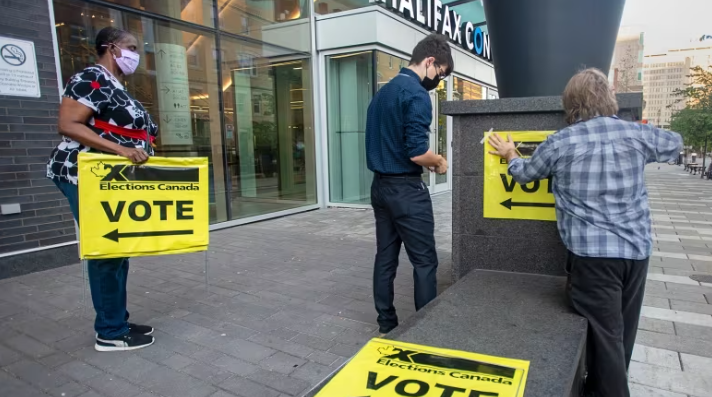A shifting electoral map could boost Conservatives in the next election

Candidates will battle to win ridings with new boundaries, demographics
The federal Conservatives may be set to benefit from a shifting electoral landscape in Canada — but that potential boost has nothing to do with the polls, or the latest twists and turns in Ottawa.
Across the country, independent commissions have finalized the process of drawing new federal ridings which will take effect in the next election, as long as it occurs after April of next year.
That process involves shifting riding boundaries to take into account changes in population and factors like economic and cultural ties between communities within ridings. Some changes move a riding boundary by a few blocks. Some move them by a few hundred kilometres.
All told, the changes may work to the Conservatives’ advantage, said Éric Grenier, a podcaster and polling expert who runs thewrit.ca.
“Overall, I think the map does benefit the Conservatives more than any other party,” Grenier told CBC News.
Grenier said that while boundary changes can be important, perhaps the biggest boost to Conservative fortunes could come from the addition of new seats to the House fo Commons. The federal seat count is set to expand from 338 to 343.
“Three extra ridings in Alberta — all three of those are probably new seats for the Conservatives. The extra seat in the B.C. interior is an area where the Conservatives are likely to win,” he said. “So they are the ones that benefit from the new seats that are being added.”
One seat being added in the Brampton, Ont. area might swing the Liberals’ way, Grenier said.
Grenier said it’s important to keep in mind that broader trends in party support and the state of the campaign play much more significant roles in an election’s outcome than changes to the riding map. A changing to a riding boundary that yields a few hundred more votes for the Liberals wouldn’t matter much if they lose thousands more votes in broader support, he said.
“No one wins an election or forms the government just because of the change of the map,” Grenier said. “But if we end up in the next election and it is really tight and it comes down to a few seats, then yeah, the map will be really important.”
Fred DeLorey, the Conservative strategist who ran former leader Erin O’Toole’s 2021 campaign, is more enthusiastic about what the map means for Conservative support.
“I don’t even know if I could have designed a better map for the Conservatives,” he told CBC News.
“It’s fantastic.”
Localized effects can be significant
Dan Arnold, a strategist who ran polling for the federal Liberals from 2015 to 2022, said parties will be closely analyzing the final maps to help with the process of identifying target ridings.
But he echoed Grenier’s conclusion that the shifting boundaries are unlikely to be a decisive factor in the next election.
“I think in some respects people get a little bit hung up on the vote shifts when you redraw the map,” he told CBC News.
Boundary changes can still be decisive in individual ridings, Grenier said. New maps could mean a seat in the Laurentians flipping to the Bloc, he said, or a Toronto riding expanding into the broader GTA and, in the process, giving the Conservatives a better shot.
Arnold said he suspects the Liberals will be eyeing Desnethé-Missinippi-Churchill River, a seat in northern Saskatchewan that is now made up almost entirely of Indigenous communities.
He said that while the once-in-a-decade redraft might have only marginal effects, the broader demographic trends — such as the growing clout of Western Canada — are factors to which Liberals must pay attention.
The independent commissions do not consider partisan outcomes when they are drawing their boundaries. MPs are often extremely vocal about changes to their ridings, however, and do try to influence the process by attending public consultations and submitting formal objections to the commissions.
The most controversial decisions the independent commissions make are the ones that eliminate ridings altogether. In Quebec’s Gaspé Peninsula, for example, two MPs will soon represent the peninsula instead of three. Northern Ontario is losing a riding, while a seat in Toronto is being divided up between its neighbours.
Not only do these decisions mean fewer MPs for a specific area, they also force sitting MPs to decide whether to seek nominations in neighbouring ridings. That reduces the boost parties typically receive from having an incumbent candidate, Grenier said.
“It levels the playing field a little bit,” he said. “And if there [are] some cases where you have incumbent MPs having to go up against each other [for nominations], I mean that’s a net loss for the party, right? Because they would rather have two incumbents.”
DeLorey said the nomination question is particularly important and it will be up to the parties to decide whether to shelter incumbents. During the last redistribution, he said, Conservatives allowed free nominations.
“All of our incumbents had to go through it. They had to. And some of them lost. It’s a part of the democratic process,” he said.
“It would be interesting to see if the parties stick to that.”
Related News
Trade war, slumping border traffic: What does that mean for the Gordie Howe bridge?
Amid U.S. President Donald Trump’s tariffs which have triggered a trade war with Canada, cross-border trips haveRead more
Trump administration threatens Harvard’s foreign enrolment, tax-exempt status
U.S. Homeland Security Secretary Kristi Noem speaks during an event on April 9, in Washington,Read more
